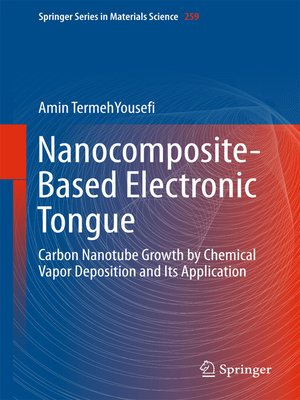Nanocomposite-Based Electronic Tongue
ebook ∣ Carbon Nanotube Growth by Chemical Vapor Deposition and Its Application · Springer Series in Materials Science
By Amin TermehYousefi

Sign up to save your library
With an OverDrive account, you can save your favorite libraries for at-a-glance information about availability. Find out more about OverDrive accounts.
Find this title in Libby, the library reading app by OverDrive.



Search for a digital library with this title
Title found at these libraries:
| Library Name | Distance |
|---|---|
| Loading... |
This book describes the fabrication of a frequency-based electronic tongue using a modified glassy carbon electrode (GCE), opening a new field of applying organic precursors to achieve nanostructure growth. It also presents a new approach to optimizing nanostructures by means of statistical analysis.
The chemical vapor deposition (CVD) method was utilized to grow vertically aligned carbon nanotubes (CNTs) with various aspect ratios. To increase the graphitic ratio of synthesized CNTs, sequential experimental strategies based on response surface methodology were employed to investigate the crystallinity of CNTs. In the next step, glucose oxidase (GOx) was immobilized on the optimized multiwall carbon nanotubes/gelatin (MWCNTs/Gl) composite using the entrapment technique to achieve enzyme-catalyzed oxidation of glucose at anodic potentials, which was drop-casted onto the GCE. The modified GCE's performance indicates that a GOx/MWCNTs/Gl/GC electrode can be utilized as a glucose biosensor with a high direct electron transfer rate between GOx and MWCNTs/Gl. It was possible to use the fabricated biosensor as an electronic tongue thanks to a frequency-based circuit attached to the electrochemical cell. The results indicate that the modified GCE (with GOx/MWCNTs/Gl) holds promising potential for application in voltammetric electronic tongues.
The chemical vapor deposition (CVD) method was utilized to grow vertically aligned carbon nanotubes (CNTs) with various aspect ratios. To increase the graphitic ratio of synthesized CNTs, sequential experimental strategies based on response surface methodology were employed to investigate the crystallinity of CNTs. In the next step, glucose oxidase (GOx) was immobilized on the optimized multiwall carbon nanotubes/gelatin (MWCNTs/Gl) composite using the entrapment technique to achieve enzyme-catalyzed oxidation of glucose at anodic potentials, which was drop-casted onto the GCE. The modified GCE's performance indicates that a GOx/MWCNTs/Gl/GC electrode can be utilized as a glucose biosensor with a high direct electron transfer rate between GOx and MWCNTs/Gl. It was possible to use the fabricated biosensor as an electronic tongue thanks to a frequency-based circuit attached to the electrochemical cell. The results indicate that the modified GCE (with GOx/MWCNTs/Gl) holds promising potential for application in voltammetric electronic tongues.







